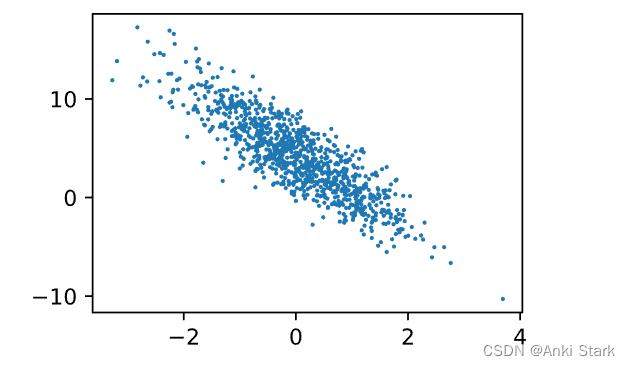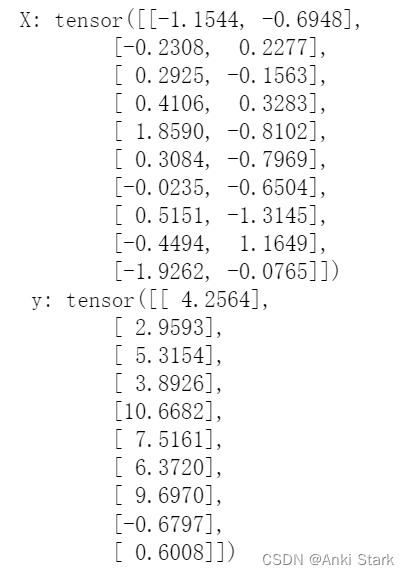注释理解
这边有更详尽的代码注释(我只是为了记录一下)
https://blog.csdn.net/lj_FLR/article/details/123760433
import random
import torch
from d2l import torch as d2l
#人造数据集
def synthetic_data(w, b, num_example):
"""生成 y = Xw + b + 噪声"""
X = torch.normal(0, 1, (num_example, len(w))) #生成均值为0, 方差为1 的随机数,num_example 个样本,列数为 w 的长度
y = torch.matmul(X, w) + b
print("y_shape:", y.shape)
y += torch.normal(0, 0.01, y.shape) # 加入随机噪音
print("y:", y[0])
return X, y.reshape((-1, 1)) # y从行向量转为列向量
true_w = torch.tensor([2, -3.4])
true_b = 4.2
features, labels = synthetic_data(true_w, true_b, 1000)
print("features:", features[0])
print("labels:", labels[0]) # y 等价于 label, X 等价于 features
d2l.set_figsize() # 以房价为例,label是真实售价,feature是预测标签的因素
d2l.plt.scatter(features[:, 1].detach().numpy(), # 从计算图中detach出来再转到numpy中去,此处 1 表示第一列的数据,对应 上面-3.4,因为是负数,所以和label呈负相关
labels.detach().numpy(), 1); # 最后一个数值 1 表示绘制点直径的大小

#读数据集
def data_iter(batch_size, features, labels):
num_examples = len(features)
indices = list(range(num_examples))
random.shuffle(indices) #将序列的元素随机打乱
for i in range(0, num_examples, batch_size):
batch_indices = torch.tensor(
indices[i : min(i + batch_size, num_examples)]) #这里取 min(),可能最后的数据不到一个batch_size的长度,
yield features[batch_indices], labels[batch_indices] #yield 每次不断返回通过 batch_indices 索引取出的数值
batch_size = 10
for X, y in data_iter(batch_size, features, labels):
print("X:",X, '\n y:', y)
break #此处 break ,返回一次迭代,即返回一个 batch_size 的数据

#初始化模型参数
w = torch.normal(0, 0.01, size=(2, 1), requires_grad = True) # requures_grad = True 表明需要计算梯度
b = torch.zeros(1, requires_grad = True) # 偏差 b 直接赋值为 0, 标量
#定义模型
def linreg(X, w, b):
"""线性回归模型"""
return torch.matmul(X, w) + b
#定义损失函数
def squared_loss(y_hat, y):
"""均方损失"""
return (y_hat - y.reshape(y_hat.shape)) ** 2 / 2
#定义优化算法
def sgd(params, lr, batch_size): # param: [w, b], lr 即学习率
"""小批量随机梯度下降(mini-batch stochastic gradient descent)"""
with torch.no_grad(): #首先定义不要计算梯度,因为我们更新的时候不需要参与梯度计算
for param in params:
param -= lr * param.grad / batch_size
param.grad.zero_() # #接下来把梯度设成0,因为pytorch不会帮你自动梯度设0,这样下一次计算梯度的时候,就不会跟上一次相关了
lr = 0.03
num_epochs = 3
net = linreg
loss = squared_loss
for epoch in range(num_epochs):
for X, y in data_iter(batch_size,features, labels):
l = loss(net(X, w, b), y) #因为 l 形状是(batch_size,1),而不是一个标量
l.sum().backward() #沐神这边说,求导 x.backward() 等价于 x.sum().backward()
sgd([w,b],lr, batch_size)
with torch.no_grad():
train_l = loss(net(features, w, b), labels)
print(f'epoch {epoch + 1}, loss {float(train_l.mean()):f}')
print(f'w的估计误差: {true_w - w.reshape(true_w.shape)}')
print(f'b的估计误差: {true_b - b}')

其实,关于 with torch.no_grad() 和 l.sum().backward() 这两处并不很理解(虽然写了注释),不是很懂sum()的含义,希望后续深入之后加深理解,希望大佬指正。





















 526
526











 被折叠的 条评论
为什么被折叠?
被折叠的 条评论
为什么被折叠?








